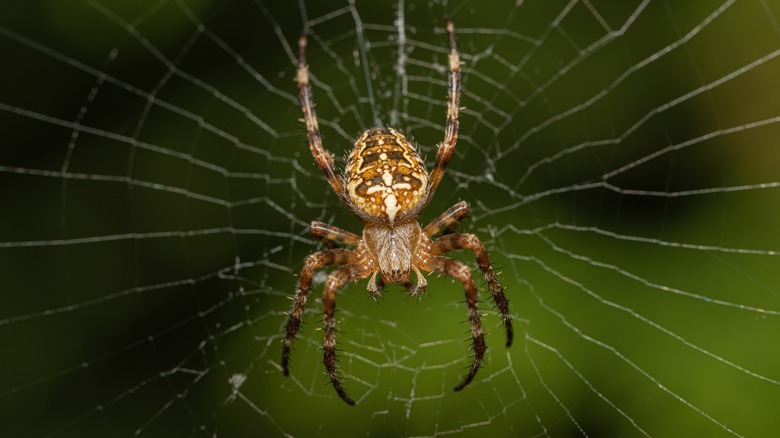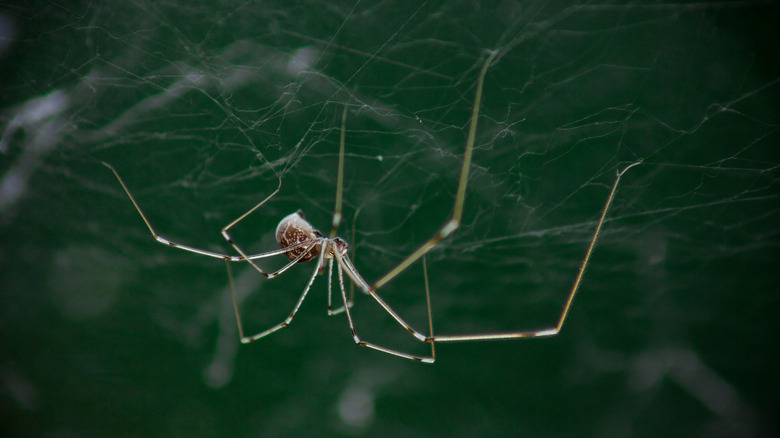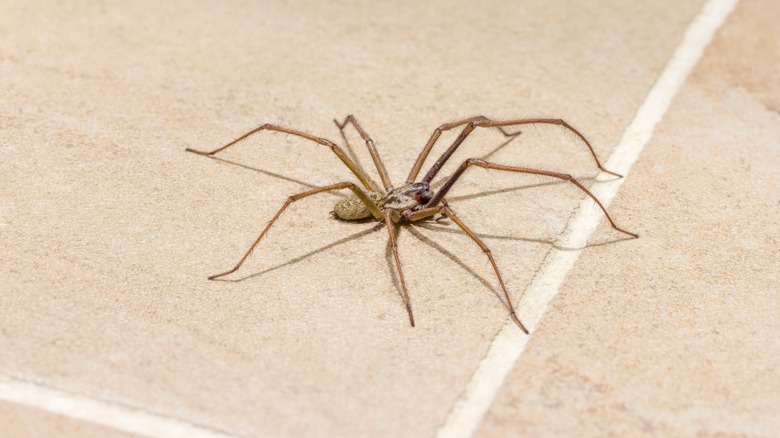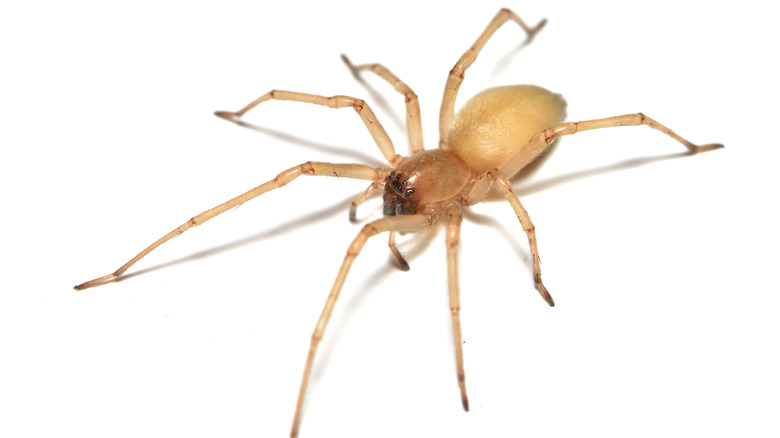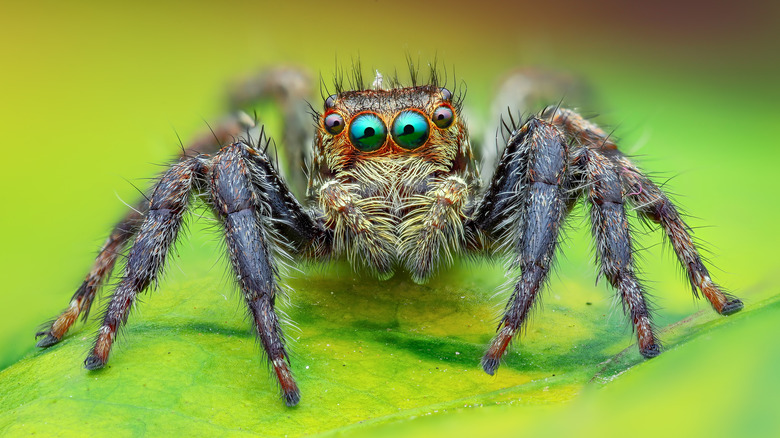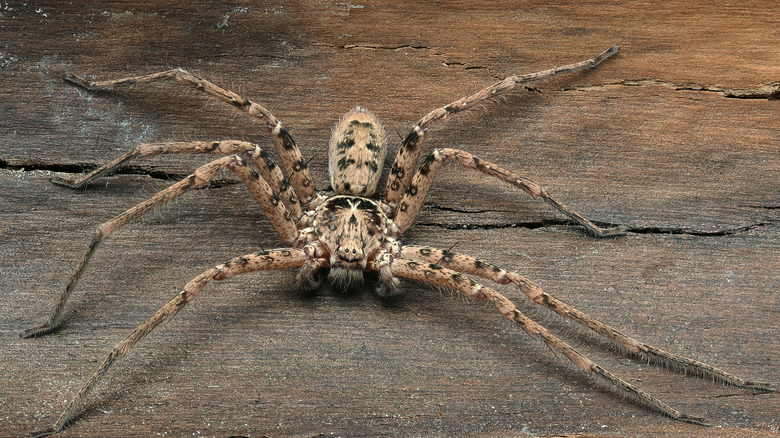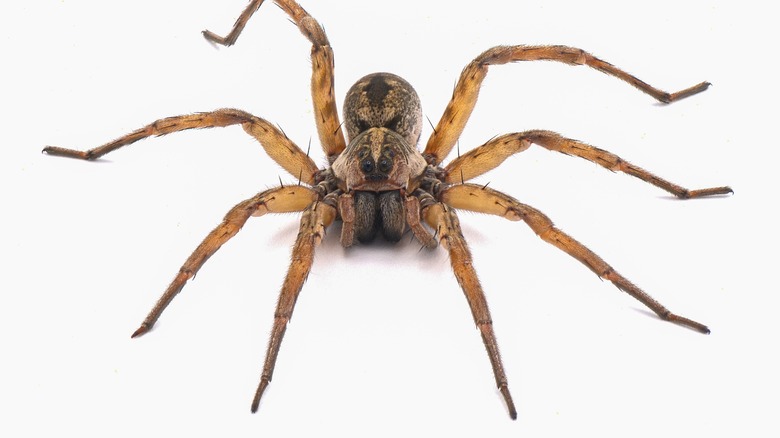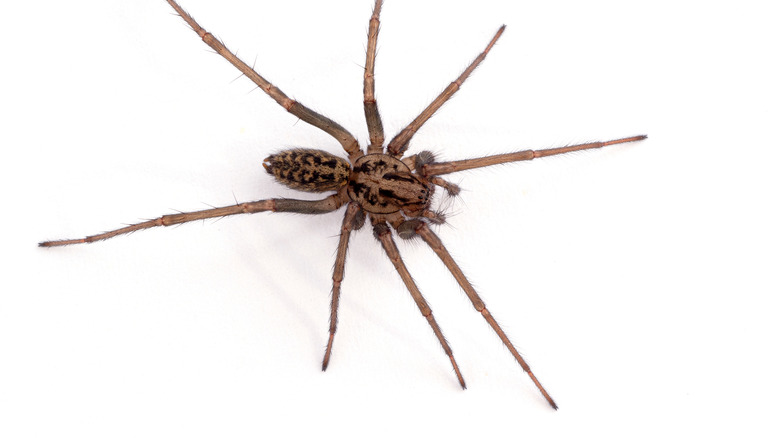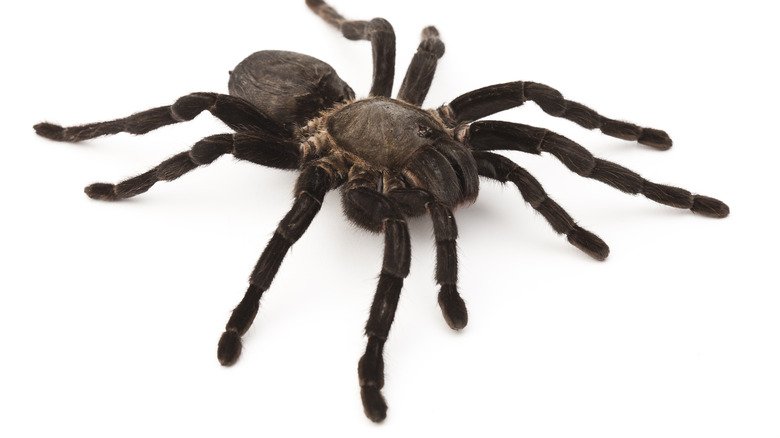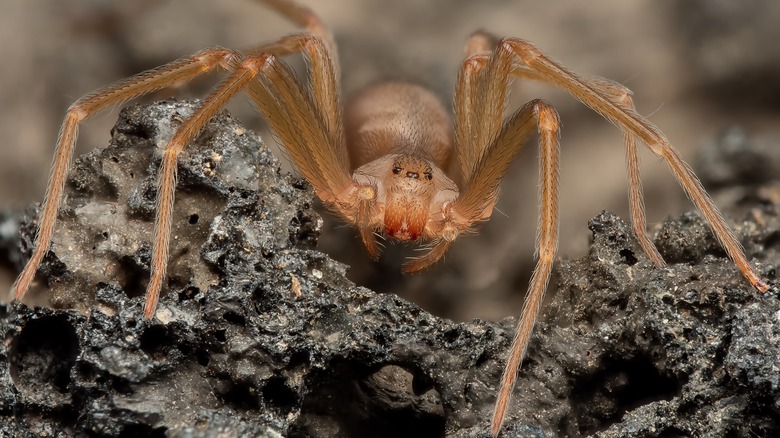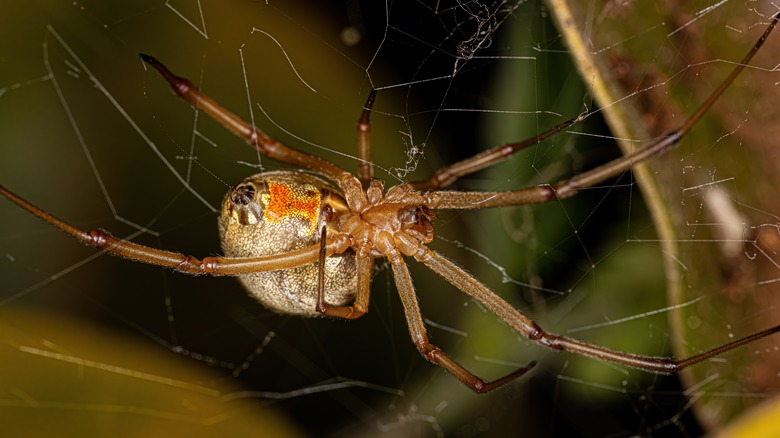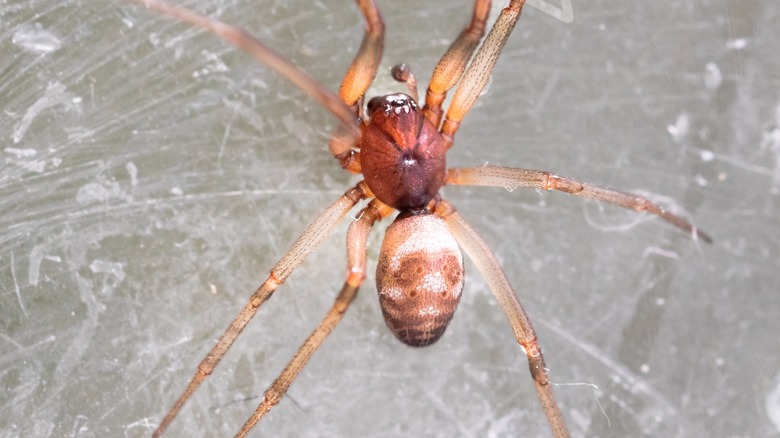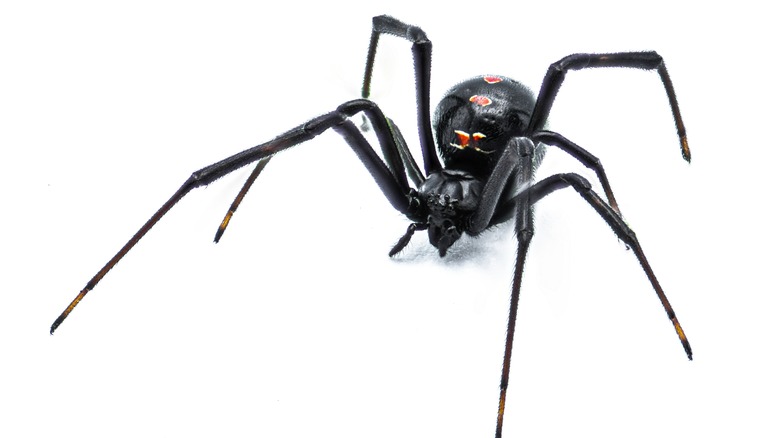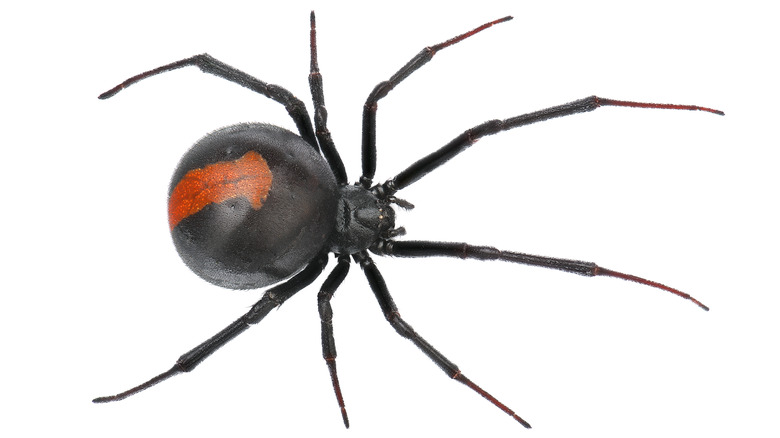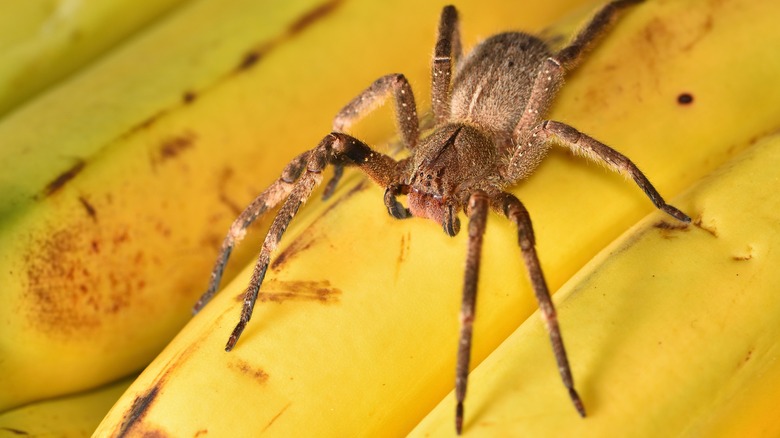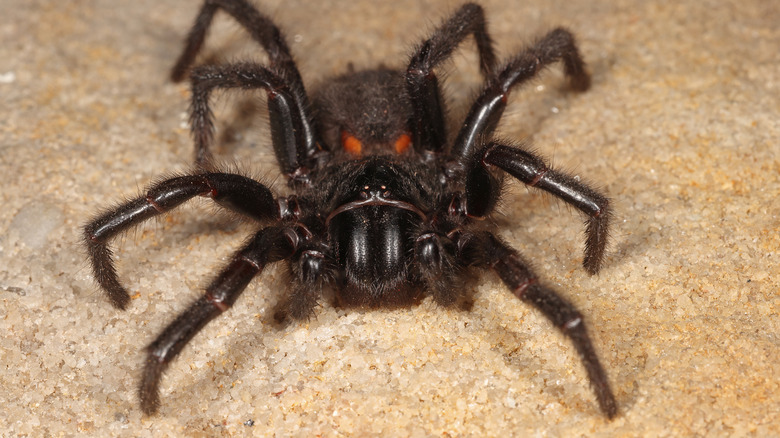15 Types Of Spiders, Ranked By Danger Level
In the intricate web of the natural world, spiders are often painted as creatures of fear and danger. Yet, beneath the surface lies a reality often overlooked: spiders are typically shy and reserved beings, opting to avoid human interaction whenever possible. According to Kids Health, they only resort to biting when provoked or inadvertently trapped, contrary to the common misconception of them as aggressive predators.
When they do bite, spider bites, despite their notorious reputation, are generally harmless. While all spiders carry poison, not all spiders contain the glands necessary to deliver this poison to humans via bite. Technically, their poison would only cause harm to you if you ingested the spider. However, it's a different story when it comes to venomous spiders. These spiders do have the ability to inject humans with their venom via bites, and some venomous spiders possess toxins that can cause serious harm, leading to potentially severe consequences if not treated promptly.
While we might all freak out if we see bite marks on our bodies after recently encountering a spider, not all bites warrant a trip to the hospital. But some might. In this ranking, we'll explore 15 species of spiders, each with its unique level of danger if a bite were to occur.
15. Cellar spider
Pholcus phalangioides, also known as "daddy longlegs" or cellar spiders, belongs to the Pholcidae family. Recognized by their elongated legs and delicate appearance, they commonly inhabit dark, humid environments like basements, caves, and cellars, where they construct irregular webs to catch prey.
Cellar spiders are generally considered harmless to humans and typically display non-aggressive behavior. Preferring to avoid human contact, they are shy and reclusive creatures. Interestingly, they are beneficial as they contribute to controlling populations of other pests, such as flies and mosquitoes.
Despite their reputation, there are no documented cases of any pholcid spider biting humans and causing harm. However, a prevalent myth erroneously labels them as one of the most lethal spider species. This myth lacks scientific support, as the venom composition and potency of these spiders have never been formally studied. Studies indicate that if a person were to be bitten, the effects are usually mild and inconsequential. For instance, a 2019 study in Frontiers in Ecology and Evolution found minimal adverse reactions to bites from cellar spiders.
14. Common House spider
The common house spider, scientifically known as Parasteatoda tepidariorum, is one of the most widespread and well-known spider species found in human habitats worldwide. Like daddy longlegs, these spiders are often encountered indoors, where they build irregular webs in corners, crevices, and other sheltered areas. However, they are distinguished by their darker ring-like pigmentation on their legs.
The threat level posed by common house spiders is minimal. They are not aggressive toward humans and are more likely to flee than bite when encountered. Additionally, their fangs are not well-suited for penetrating human skin, further reducing the likelihood of bites occurring. If one were to aggravate the common house spider so intensely that it does retaliate with a bite, their venom is relatively mild, rendering their bites typically harmless to humans (via Western Exterminator). There has only been one case of a serious reaction to a bite by a common house spider, but this was because the victim was allergic (via the University of Florida IFAS).
13. Yellow Sac spider
The yellow sac spider, scientifically known as Cheiracanthium inclusum, is a globally distributed species found across various regions, including North America. These spiders are easily recognizable by their pale yellow to light green coloration. Despite their relatively lower profile compared to other spiders, yellow sac spiders have garnered interest due to their unique web-spinning behavior. Instead of the intricate webs commonly associated with spiders, they construct sacs using their silk, a behavior noted by Truly Nolen.
Regarding their potential danger to humans, yellow sac spiders are considered medically significant, although the extent of their threat remains a subject of debate. A study published in the American Journal of Tropical Medicine and Hygiene has shed light on this issue. The study discovered that in many cases where people thought yellow sac spiders caused severe reactions, subsequent searches didn't find any of these spiders nearby. The researchers suggested that in these cases, other bugs were probably the real culprits. However, because yellow sac spiders are common, they often get blamed for the bites.
In a comprehensive multi-year study covering the United States and Australia, these researchers confirmed that yellow sac spiders were involved in only about 20 reported spider bite cases. Usually, these bites caused intense pain around the bite spot, but symptoms didn't last long, and most people didn't need medical help, suggesting that yellow sac spiders do not serve the dangerous reputation they have garnered.
12. Jumping spider
Jumping spiders, members of the Salticidae family, are renowned for their agility, acute vision, and unique hunting techniques. With a staggering diversity of over 5,000 described species inhabiting various ecosystems worldwide, these spiders stand out as some of the most charismatic and easily identifiable arachnids.
Despite their prevalence, jumping spiders are generally harmless to humans. Research cited in a Toxicon study suggests that although they account for around 5% of spider bites in Australia, their bites are typically mild and pose minimal risk. Affected individuals may experience minor discomfort, redness, and swelling akin to a mosquito bite at the site of the incident (via PestWorld). Severe reactions or systemic effects are exceptionally rare and usually occur in individuals with heightened sensitivity or allergies to spider venom, according to PestWorld. It's important to note that jumping spiders are more inclined to leap away from humans than to engage in aggressive behavior, further minimizing the likelihood of encounters resulting in bites.
11. Huntsman spider
Ah, the huntsman spider — every Aussie's unofficial roommate, lurking in the corners of homes, sheds, and garages, always ready to surprise you with its impressive size and lightning-fast movements. Belonging to the family Sparassidae, these giants of the spider world are known for their agility and distinctive appearance that can send shivers down your spine faster than a kangaroo hopping by. But fear not! Despite their formidable size and fearsome reputation, huntsman spiders are actually quite beneficial. They happily feast on insects, playing a crucial role in keeping pest populations in check.
While huntsman spiders aren't shy about defending themselves if provoked, their bites are usually more of a nuisance than a cause for alarm. Think of it as similar to the annoyance of a bee or wasp sting: pain, redness, and swelling at the site of the bite (via Miche Pest Control). Severe reactions or systemic effects are about as rare as finding a drop bear in your backyard. Only those with extreme sensitivity or allergies to spider venom need to worry, and even then, encounters are few and far between. So, rest easy knowing that your eight-legged roommates are more likely to skedaddle than show any aggression toward you.
10. Wolf spider
Embodying the true essence of "lone wolves," these spiders have earned their name. Solitary by nature, the wolf spider, belonging to the family Lycosidae, lives and hunts independently, only coming together during mating season in the fall. With over 200 described species scattered across North America alone (via Terminix), wolf spiders stand as one of the most prevalent and diverse spider families.
In terms of threat to humans, wolf spiders pose minimal danger. Preferring solitude, they typically steer clear of human interaction whenever possible. However, they may venture into human habitats in pursuit of prey or refuge, especially where their natural environments intersect with urban areas.
Despite their imposing size and appearance, wolf spiders are far from aggressive toward humans. When encountered, they're more inclined to flee than to bite. While their bite can be painful if provoked or threatened, their venom is relatively weak and rarely poses any serious risk to humans. Symptoms typically resemble those of a bee or wasp sting, including pain, redness, and swelling at the bite site. Severe reactions or systemic effects are exceedingly uncommon and usually occur in individuals with specific sensitivities or allergies to spider venom.
9. Hobo spider
The hobo spider, scientifically known as Tegenaria agrestis, has earned notoriety for its perceived danger to humans, particularly in the Pacific Northwest region of North America. Despite the fact that they are mostly confined to this area, hobo spiders are often erroneously assumed to be present throughout the United States. This misconception has led to misdiagnoses of bites, even in areas where hobo spiders have never been documented, suggesting an overestimation of their danger based on reputation rather than actual evidence (via Catseye Pest).
The idea that hobo spiders can cause skin damage in North America is based on only a little bit of evidence. Some research says hobo spider venom might cause serious skin wounds in people, but other studies say there isn't enough proof for this. Actually, there's only one confirmed case of a serious skin wound from a hobo spider bite in medical records, according to a study in the Annals of Emergency Medicine.
This lack of clear evidence makes it uncertain how dangerous hobo spiders really are to people. It's important to be careful when considering how much harm they might cause. Despite their reputation, there isn't strong evidence linking hobo spiders to serious skin wounds. So, it's vital to carefully assess claims about their danger and not just rely on stories or what people commonly believe. Overall, hobo spiders are considered to pose a relatively low risk to humans.
8. Tarantulas
Tarantulas, belonging to the family Theraphosidae, are large and hairy spiders commonly found in various habitats such as burrows, tree hollows, and rock crevices. While they are often encountered outdoors, they may also venture into homes in search of prey or shelter.
Despite their fearsome reputation, tarantulas are typically not aggressive towards humans and are even kept as pets due to their docile nature. While they may exhibit defensive behaviors if threatened, they are more likely to retreat than to bite. In instances where tarantulas do bite, they often deliver dry bites that may cause pain but do not inject venom. In the rare cases where venom is injected, their venom is actually relatively weak and not usually harmful to humans (via Western Exterminator). Thus, the average, healthy adult human does not need to worry about tarantulas. They actually play crucial roles in ecosystems as predators of insects and other small animals and don't necessitate the fear that they usually evoke.
7. Brown Recluse spider
The brown recluse spider, scientifically known as Loxosceles reclusa, is a venomous spider species primarily found in the central and southern United States. Notorious for its venom, which can cause tissue-destroying wounds, brown recluse spiders tend to inhabit dark, secluded areas like basements, attics, closets, and woodpiles.
The threat level posed by brown recluse spiders is higher compared to many other spider species due to the potential severity of their bites. Their venom can induce various symptoms, ranging from mild irritation to severe tissue damage and systemic effects. Nonetheless, it's crucial to highlight that bites from these spiders are relatively uncommon, and not all bites lead to severe symptoms. Most bites result in mild reactions like redness, pain, and swelling at the bite site, akin to a bee or wasp sting.
Individuals bitten by a brown recluse spider may notice redness, pain, and swelling in the affected area. My Health Alberta recommends seeking medical attention promptly, especially if symptoms progress to blistering, ulceration, or tissue death. In severe cases, systemic symptoms like fever, nausea, vomiting, and muscle pain may also manifest. Timely medical intervention is vital to prevent complications and aid in healing.
6. Brown Widow spider
The brown widow spider, closely related to the black widow, is found in warm climates worldwide, including North America, Africa, Asia, and Australia. While brown widow spiders primarily inhabit outdoor areas such as gardens and yards, they may enter homes seeking shelter.
Despite being less aggressive than black widows, brown widows may bite if threatened. Still, the brown widow's bites are less common due to their more timid behavior and lower abundance.
Although its venom is similar to the black widow's and still considered medically significant, brown widow bites are typically less potent and cause milder reactions. Symptoms of a brown widow bite include pain, redness, swelling, and occasionally muscle cramps. In rare cases, more severe symptoms such as nausea, vomiting, headache, and fever may occur, and there has even been one report of a victim requiring hospitalization. Although brown widow venom is as toxic as other widow species, it's typically viewed as having a weaker effect on humans, likely due to the smaller amount of venom injected during a bite (via UC Riverside).
5. Red Widow spider
The red widow spider, named for its vibrant red coloration, is a native species found exclusively in Florida. Similar to other widow spiders, it possesses potent venom capable of causing various symptoms in humans, similar to those of other spider bites.
One distinctive aspect of the female red widow's bite is the presence of a neurotoxin that induces sustained muscle spasms. This characteristic underscores the importance of seeking medical attention if bitten by a red widow spider. Despite this potential danger, documented cases of injuries or fatalities attributed to red widow spiders are rare. This rarity is likely due to the limited spaces in which humans commonly encounter these spiders, given their range is typically limited to Florida. Still, to prevent any chance of a bite, Imagine Our Florida recommends wearing gloves when picking up wood and other items where red widows may have nested, given that they have been known to make homes in sheds and garages.
4. Black Widow spider
Renowned not only as a popular comic book character, the female black widow spider is oft-labeled as one of the most notorious and venomous spider species in North America. Its habitat extends to parts of Europe, Asia, and Australia. Distinguished by its shiny black appearance and the iconic red hourglass-shaped marking on its abdomen's underside, the black widow spider is instantly recognizable. Known for their defensive behavior when disturbed, black widow spiders may bite humans, albeit infrequently due to their secretive nature.
Armed with potent neurotoxic venom, the black widow's bite can induce a spectrum of symptoms like severe pain, muscle cramps, nausea, vomiting, or breathing difficulties (via Nature Conservancy Canada). Although permanent disability or death is uncommon, black widow bites can cause severe pain and painful muscle contractions, emphasizing the importance of seeking medical care promptly, particularly for vulnerable individuals. Compared to other widow spiders, the black widow's venom is particularly potent, which is why its threat level is elevated compared to other widow spiders.
3. Australian Redback spider
The Australian redback spider, Latrodectus hasselti, native to Australia, is akin to the black widow spider in characteristics, including the red marking on its abdomen (via Australian Museum). Found across Australia, particularly in urban areas, it's a medically significant species due to its potent neurotoxic venom. Though only the female's bite poses a threat, individuals should seek medical attention promptly since it's hard for the average person to be certain of whether they were bitten by a male or female.
Though less likely to bite unless disturbed, when provoked, redback spiders may bite in defense or when trapped. Symptoms of a bite include severe pain, sweating, weakness, nausea, and vomiting. Antivenom is available, and deaths post-antivenom introduction are unheard of, though they have occurred in rare cases in the past.
While fatalities are uncommon, severe reactions are possible, particularly in vulnerable populations. Practicing caution to avoid encounters and seeking immediate medical help if bitten are crucial steps to manage risks associated with Australian redback spiders.
2. Brazilian Wandering spider
The Brazilian wandering spider, Phoneutria spp., found in South and Central America, is known for its highly venomous bite and aggressive hunting behavior. Unlike web-building spiders, these arachnids actively roam forest floors at night to hunt prey. Notably, their venom is infamous for causing painful and prolonged erections, as seen in a 2008 study by BJU International.
Symptoms of a bite include burning pain, sweating, and systemic effects such as blood pressure fluctuations, nausea, abdominal cramping, vertigo, and convulsions. Despite their potency, spiders typically do not inject all their venom during a bite, as it's also needed for hunting. Envenomations are generally mild, with only a small percentage requiring antivenom. Roughly 4,000 bites occur annually in Brazil, with few cases being severe and only 15 deaths reported since 1903, according to Live Science. Prompt treatment with antivenom and supportive care can mitigate venom effects and prevent complications.
1. Sydney Funnel-web spider
The Sydney funnel-web spider, Atrax robustus, native to Australia, is infamous for its potent venom and aggressive behavior, especially among males during mating season. Considered one of the world's most dangerous spiders, its bites pose significant risks to humans. Their venom contains a potent neurotoxin, inducing severe symptoms like intense pain, muscle spasms, respiratory distress, and even death in severe cases. Prompt medical attention is crucial to administer antivenom and manage symptoms effectively.
With their aggressive nature and tendency to enter human habitats, encounters with Sydney funnel-web spiders carry an extremely high threat level. Male spiders, more active at night, often enter homes during mating season, increasing human encounters, as reported in a study in the National Library of Medicine. Fatalities are usually associated with male spiders, known for their wandering behavior. The onset of severe symptoms is rapid, with death possible within 15 minutes to three days, especially in children or those with underlying health conditions. Thus, immediate medical attention is imperative for anyone bitten.
Applying a pressure immobilization bandage can help slow venom spread while cleaning the bite site with soap and water and applying a cold compress can reduce pain and swelling. While fatalities are rare due to antivenom availability and prompt treatment, severe reactions can be life-threatening, especially in untreated cases or individuals allergic to spider venom. Encounters with Sydney funnel-web spiders should be treated seriously.
